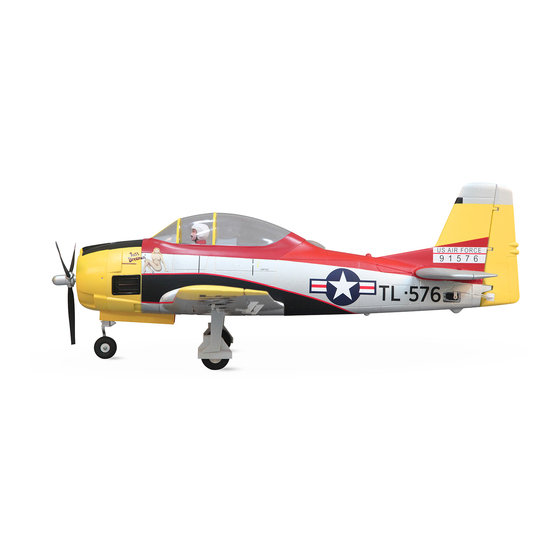
Inhaltsverzeichnis
Werbung
Verfügbare Sprachen
Verfügbare Sprachen
Quicklinks
Werbung
Inhaltsverzeichnis
Fehlerbehebung

Inhaltszusammenfassung für Modster Hobby Arrows 1100mm T-28
- Seite 1 1100mm T-28 Operating Manual...
-
Seite 2: Sicherheitshinweise Und Warnungen
Warnung: Dieses Handbuch enthält wichtige Informationen, mit denen Sie Ihr Modellflugzeug zuverlässig und sicher warten und betreiben können. Bitte lesen Sie die Anweisungen und Warnungen vor der Montage, Einrichtung oder Verwendung sorgfältig durch. Da es sich bei diesem Modellflugzeug um ein hoch entwickeltes Hobbyprodukt handelt, muss es unter Berücksichtigung der Sicherheit und des gesunden Menschenverstandes geflogen werden. -
Seite 3: Inhaltsverzeichnis
Einleitung Der nordamerikanische T-28 „Trojan“, ein kolbenmotorgetriebenes Zweisitzer-Flugzeug, war der letzte Trainer seiner Art, den die United States Air Force und Navy in Dienst nahmen. Dieses in den 1950er Jahren entworfene Modell spielte eine Schlüsselrolle beim Wechsel der Piloten von Basistrainern zu Düsenflugzeugen. Die Arrows Hobby T-28 ist heute eines der am einfachsten zu fliegenden Flugzeuge auf dem Markt. - Seite 4 Bauanleitung Flügel-Installation 1. Führen Sie alle Kabel des Flügels über den Rumpfdurchgang in den Rumpf ein. Befestigen Sie den Flügel am Rumpf und stellen Sie sicher, dass die Drähte keines der Servos stören. 2.Sichern Sie den Flügel mit den mitgelieferten Schrauben wie gezeigt am Rumpf. Ziehen Sie die Schrauben nicht zu fest HKM3.0*32 mm Höhenleitwerk-Installation 1.Schieben Sie die Höhenleitwerk-Stange in den Schlitz nahe der Rückseite des Rumpfes.
-
Seite 5: Propeller- Und Spinner-Installation
Bauanleitung Schubstangen-Installation 1.Verbinden Sie das Höhenruder-Servo mit der Schub- stange. 2. Verbinden Sie das Seitenruder-Servo mit derSchubstange. Propeller- und Spinner-Installation 1. Montieren Sie Spinner und Propeller wie rechts gezeigt. Hinweis: Der Motor sollte sich beim Betrachten des Flugzeugs von hinten im Uhrzeigersinn drehen. -
Seite 6: Akku-Installation
Akku-Installation 1. 1. Entfernen Sie die Verschlussklappe des Akkus. 2. Entfernen Sie das Klettband vom Rumpf. Bringen Sie die Schleifen-Seite am Akku an. 3. Setzen Sie den Akku in den Rumpf ein und sichern Sie sie mit den vorinstallierten Bändern. Hinweis: Das Gewicht jedes Akkus kann aufgrund unter- schiedlicher Herstellungstechniken variieren. -
Seite 7: Gabelkopf-Installation
Vorflug-Check Sender- und Modell-Einstellung Stellen Sie nach der Montage und vor Ihrem ersten Flug sicher, dass alle Bedienoberflächen korrekt (wie auf dem Diagram unten angegeben) auf Ihren Sender reagieren. Höhenruder Seitenruder Querruder Ruderausschlag Die empfohlene Einstellung für den Ruderausschlag lautet wie folgt (Servo-Wegbegrenzung): Tipp: Der Jungfernflug sollte immer mit kleinem Großer Ausschlag... -
Seite 8: Ruderhorn- Und Servoarm-Einstellung
Ruderhorn- und Servoarm-Einstellung Mehr Ausschlag Horn 1. Die Tabelle zeigt die Werkseinstellungen für die Ruderhörner und Servo-Arme. Fliegen Sie das Flug- zeug in den Werkseinstellungen, bevor Sie Änderun- gen vornehmen. Weniger Ausschlag 2. Nach dem Fliegen können Sie die Verbindung anpassen. -
Seite 9: Flug-Tipps
Vor dem Fliegen Schalten Sie Ihren Sender immer zuerst ein. Installieren Sie einen vollständig geladenen Akku im Akkufach und schließen Sie ihn an den Regler an. Stellen Sie bei diesem Vorgang sicher, dass die Gasfunktion aktiviert ist und der Gashebel in seiner niedrigsten Position gesichert ist. -
Seite 10: Problembehebung
Problembehebung Problem Möglicher Grund Lösung Gashebel und -trimmer auf niedrigsten Wert stellen. Flugzeug reagiert nicht auf Drehzahlregler (ESC) ausgeschaltet. Gashebel, aber auf andere Gaskanal seitenverkehrt eingestellt. Befehle. Gaskanal am Sender umdrehen. Spinner, Propeller, Motor o. Defekte Teile ersetzen. Flugzeug reagiert nicht auf Teile an Propeller(-Adapter) und Spinner festziehen. -
Seite 11: Aufkleber-Anbringung
Aufkleber-Anbringung 1. Legen Sie den Aufkleber in Wasser, bis er vollgesogen ist. 2. Entfernen Sie den Aufkleber vorsichtig vom Trägerpapier und bringen Sie ihn an der entsprechenden Position der Flugzeugzelle an. Es wäre hilfreich, diese Stelle am Modell zuvor mit Wasser zu benetzen. 3.















